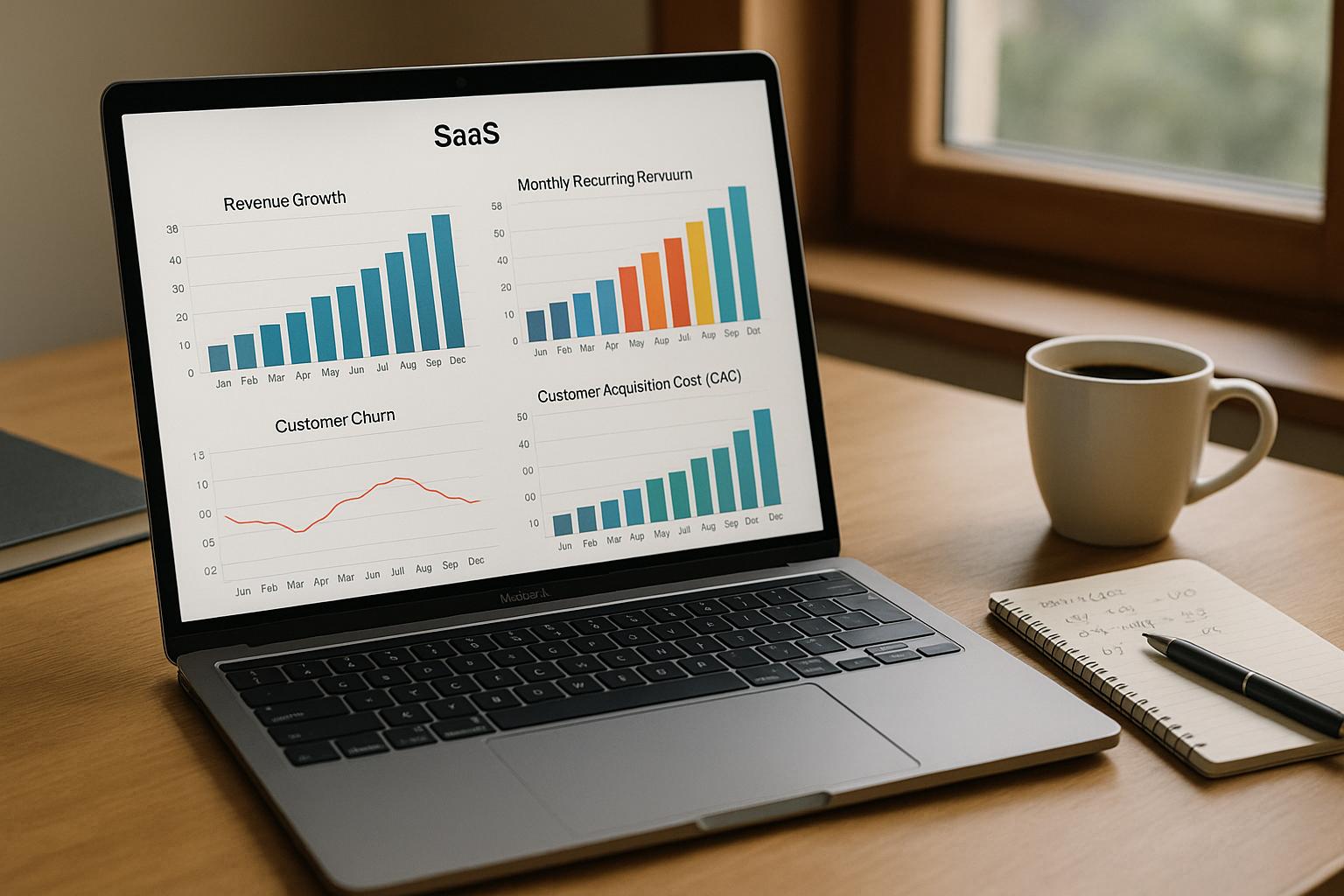KPI-Driven Financial Modeling for SaaS

KPI-driven financial modeling helps SaaS companies connect key metrics to growth and financial goals. Unlike traditional models, this approach focuses on SaaS-specific metrics like recurring revenue, churn, and customer acquisition costs (CAC). Here’s why it matters:
- Revenue Recognition: SaaS revenue is recognized monthly, not upfront, making accurate modeling essential.
- Customer Acquisition Costs: High upfront costs require long-term customer value (LTV) to justify spending.
- Growth vs. Profitability: Early-stage SaaS businesses often prioritize growth over short-term profits.
Key SaaS Metrics:
- ARR/MRR: Track recurring revenue for forecasts.
- Churn Rate: Measure customer retention and its impact on revenue.
- CAC & LTV: Ensure growth is sustainable with an LTV:CAC ratio of 3:1 or better.
Why it works: Aligning metrics with business goals allows for better resource allocation, scenario planning, and real-time adjustments. SaaS companies can use tools and financial advisory services to improve accuracy, automate data, and make informed decisions.
Key SaaS KPIs for Financial Modeling
When it comes to building effective SaaS financial models, a few key metrics take center stage. These are the numbers that shape strategic decisions and help ensure financial plans stay on track.
Annual Recurring Revenue (ARR) and Monthly Recurring Revenue (MRR)
Annual Recurring Revenue (ARR) and Monthly Recurring Revenue (MRR) are the backbone of any SaaS financial model. They represent the steady, predictable income from subscription customers, forming the baseline for all financial forecasts.
- MRR shows the recurring revenue generated monthly from active subscriptions. It’s calculated by multiplying the total number of paying customers by the average revenue per customer per month. For example, if you have 500 customers paying $100 each month, your MRR is $50,000.
- ARR takes this monthly figure and projects it over a year. Simply multiply MRR by 12. Using the same example, the ARR would be $600,000.
Unlike traditional businesses where revenue can fluctuate, SaaS companies benefit from the predictability of recurring revenue. This allows for more accurate cash flow forecasts and better planning.
Tracking MRR growth rate is crucial for understanding business momentum. Early-stage SaaS companies often see monthly MRR growth between 10-20%, while more mature companies might experience slower growth, around 5-10%. Breaking down MRR into components - like new MRR (from new customers), expansion MRR (from upgrades), and churned MRR (lost revenue) - can highlight what's driving growth or holding it back.
Churn Rate and Its Financial Impact
Churn rate is a crucial metric for SaaS businesses, as it measures the percentage of customers who cancel their subscriptions during a given period. High churn can significantly hinder growth, making it a key focus for financial modeling.
To calculate monthly churn rate, divide the number of customers lost during the month by the total number of customers at the start of the month. For instance, if you began with 1,000 customers and lost 50, your churn rate is 5%.
Churn has a compounding effect on revenue. A 5% monthly churn rate means you need to acquire enough new customers just to maintain your current revenue levels. This is why reducing churn often delivers a better return on investment than acquiring new customers.
Another important metric is revenue churn, which measures the percentage of recurring revenue lost due to cancellations or downgrades. This can differ from customer churn, especially if higher-paying customers behave differently than smaller accounts.
Achieving negative churn - where expansion revenue from existing customers outweighs losses from cancellations - is a game-changer. It means your business can grow revenue without needing to add new customers, creating a powerful compounding effect in your financial models.
Churn often peaks in the first 30-90 days as customers assess whether the product meets their needs. Factoring in these patterns can help refine revenue projections and improve modeling accuracy.
Customer Acquisition Cost (CAC) and Lifetime Value (LTV)
To round out your SaaS financial model, it’s essential to evaluate Customer Acquisition Cost (CAC) and Lifetime Value (LTV). Together, these metrics reveal whether growth is both sustainable and profitable.
- CAC is the total cost of acquiring a new customer. This includes marketing expenses, sales team costs, and any other related investments. For example, if you spend $50,000 to bring in 100 customers, your CAC is $500 per customer.
- LTV estimates the total revenue a customer will generate over their lifetime. The formula is simple: Average Revenue Per Customer ÷ Churn Rate. If your average customer pays $100 per month and your churn rate is 5%, the LTV would be $2,000.
The LTV:CAC ratio is a key indicator of profitability. A healthy SaaS business typically aims for a ratio of 3:1 or higher, meaning customers generate at least three times the revenue it costs to acquire them. If the ratio falls below 3:1, it may indicate unsustainable economics, while a ratio above 5:1 could signal under-investment in growth.
Another critical measure is the payback period, which shows how long it takes to recover your acquisition costs. Divide CAC by the monthly revenue per customer. For example, if your CAC is $500 and monthly revenue per customer is $100, the payback period is 5 months. Most successful SaaS companies aim for payback periods of 12-18 months or less.
Segmenting CAC and LTV by customer type - like small businesses versus enterprise clients - can reveal important trade-offs. While enterprise customers might have higher CAC, they often deliver much greater LTV, making them a valuable segment for long-term profitability.
Finally, tracking CAC trends over time can provide insights into your business efficiency. A rising CAC might indicate market saturation or declining marketing effectiveness, while a falling CAC could signal improved efficiency or stronger product-market alignment. These trends should directly inform your growth strategies and financial forecasts.
Building a KPI-Driven Financial Model
Once you’ve mastered the core SaaS metrics, the next step is creating a financial model that revolves around these KPIs. This model builds directly on the insights gained from metrics like ARR, churn, and CAC. By integrating these key indicators, your financial model becomes a powerful tool for forecasting growth and shaping strategies - whether it’s setting pricing, planning hires, or allocating resources.
Core Components of a SaaS Financial Model
A well-designed SaaS financial model is built on several interconnected components that reflect your company’s financial health. At its core is the revenue model, which should rely on KPI data rather than broad assumptions. Start by forecasting revenue based on your current MRR, factoring in key drivers like new customer acquisition, expansion revenue, and churn losses. This bottom-up approach keeps your projections grounded in reality.
On the expense side, SaaS businesses often follow predictable patterns. Essential costs like hosting, integrations, and customer support are unavoidable. Sales and marketing expenses, which can vary significantly, also play a major role. Cash flow projections are crucial here since there’s often a gap between the upfront cost of acquiring customers and the gradual recovery of those costs through subscriptions.
Your model should also account for balance sheet items like accounts receivable from annual contracts and deferred revenue liabilities. These have a significant impact on cash flow timing and must be carefully modeled. Unit economics - linking metrics like customer acquisition cost (CAC) and customer lifetime value (LTV) to overall financial performance - are another critical component. Breaking these metrics down by customer segments, acquisition channels, or product tiers can reveal important patterns in customer behavior. Together, these elements set the stage for dynamic scenario testing.
Scenario Analysis for KPI Testing
Scenario analysis transforms your financial model into a dynamic decision-making tool. By testing how changes in key metrics impact overall performance, you can pinpoint which factors have the greatest influence on your business outcomes.
For instance, running a sensitivity analysis on churn rates can highlight how even small improvements in retention can significantly increase lifetime value. Similarly, modeling different growth scenarios - such as varying customer acquisition rates and adjusting marketing spend - can help you identify when the costs of growth start to outweigh the benefits.
Pricing strategies can also be explored through scenario analysis. Adjusting subscription tiers allows you to evaluate how changes affect both revenue and churn across different customer segments. Additionally, market expansion scenarios can shed light on the financial implications of entering new customer demographics or regions, especially as acquisition costs evolve over time. Techniques like Monte Carlo simulations can take this a step further, providing a range of possible outcomes and the likelihood of hitting specific revenue or profitability targets.
Using Real-Time Financial Data
Static models and scenario testing are valuable, but integrating real-time data takes your financial model to the next level. In the fast-moving SaaS world, relying on models updated monthly or quarterly can leave you behind.
By connecting your financial model to operational systems in real time, you can ensure your projections stay accurate and actionable. Tools like subscription billing platforms, CRM systems, and marketing analytics solutions can automatically feed key metrics - such as MRR, churn, and CAC - into your model. This integration allows you to track performance daily, creating a feedback loop that improves forecasting accuracy.
Cohort analysis is another way to enhance your model. It offers deeper insights into customer behavior by identifying trends that simple averages might miss. Automated revenue recognition processes are also essential, especially when managing payment structures like annual contracts or usage-based pricing. These processes ensure your model accurately reflects both cash collection and revenue recognition. Finally, variance analysis helps you distinguish between short-term fluctuations and long-term shifts, enabling timely adjustments to your model.
In short, a KPI-driven financial model - backed by real-time data and scenario analysis - becomes an indispensable tool for navigating growth and staying competitive in the SaaS landscape. It’s not just about tracking numbers; it’s about using them to make smarter, faster decisions.
Best Practices for SaaS KPI Modeling
To make the most of KPI-driven financial models, it's essential to follow practices that keep data actionable and aligned with your goals. Building a strong model takes a disciplined approach to gathering data, maintaining the model, and presenting insights in a way that turns raw metrics into strategic decisions.
Using Historical Data for Forecasting
Historical data is the foundation of accurate SaaS financial forecasting. Successful companies often rely on cohort analysis to uncover patterns in customer behavior over time.
Start by breaking your historical data into meaningful cohorts - groups of customers acquired during the same period or through similar acquisition channels. This method helps you spot trends that might be hidden in overall numbers.
Seasonality is another key factor to consider. For instance, many B2B SaaS companies experience slower growth in Q4 due to budget freezes, while consumer-focused platforms might see spikes during certain months. Factoring in these seasonal trends makes your projections more reliable.
When it comes to forecasting churn, avoid relying on simple averages. Instead, analyze churn rates by customer segment, contract value, and time since acquisition. For example, enterprise customers may have lower monthly churn but higher annual contract non-renewal rates. On the other hand, small business customers often churn quickly at first but stabilize after a few months.
To refine your projections, combine cohort analysis, trend evaluations, and regression models. These insights highlight the importance of regularly updating your model to stay aligned with real-world changes.
Updating Financial Models Regularly
SaaS financial models need to evolve as your business changes. Set up a monthly refresh cycle that goes beyond simply adding updated numbers. Each month, revisit your assumptions and compare them against actual performance. Adjust for shifts in metrics like customer acquisition cost (CAC) or churn rates.
Variance analysis is particularly important during these updates. If actual results differ from projections by more than 10-15%, dig into the reasons. While some variances might be one-offs, others could point to underlying changes in your business that require you to revise your model.
Tailor your models for different purposes. For instance, a board-level model might highlight high-level KPIs and quarterly trends, while an operational model could focus on weekly details for short-term decisions. Both models should share the same core assumptions but present data at the right level of detail for their audience.
Keep a detailed log of any changes you make. Document why assumptions were updated, what data supported the changes, and how those updates impacted projections. This is especially useful when multiple team members work on the model or when explaining variances to stakeholders.
Where possible, automate data inputs. Many SaaS companies link their financial models directly to tools like subscription billing systems, CRM platforms, and marketing analytics. Automation reduces manual errors and ensures your model reflects the most current data.
Presenting KPIs for Decision-Making
Even the best financial models are useless if stakeholders can't easily understand or act on the insights they provide. Presenting KPIs effectively means tailoring the information to fit your audience and the decisions they need to make.
For executives, focus on a handful of key metrics that drive business value. Common examples include ARR growth rate, net revenue retention, customer acquisition cost, and cash burn rate. Use clear visuals, like trend lines and variance markers, to make the data easy to digest. Traffic light indicators - green, yellow, red - can quickly show how performance measures up against targets.
Operational teams need more detailed views tied to their specific roles. For instance:
- Sales teams focus on pipeline conversion rates.
- Customer success teams monitor retention metrics.
- Marketing teams track cost per lead and channel performance.
Make important metrics stand out visually. For example, use consistent color schemes across reports - such as blue for revenue and red for costs - to help stakeholders quickly interpret the data.
Always provide context to make the numbers meaningful. For example, instead of just stating that MRR grew 8% last month, explain whether this growth is an improvement or a slowdown compared to recent trends. Including benchmarks, like industry averages, adds further clarity. For instance, how does your 15% annual churn rate stack up against competitors with similar customer profiles?
Every KPI should lead to actionable insights. If customer acquisition cost jumps by 25%, what’s the next step? Should you shift marketing budgets, focus on higher-value channels, or work on improving conversion rates? Always connect metrics to clear recommendations.
Finally, adapt your presentation format to the meeting type. For board meetings, stick to high-level summaries with year-over-year comparisons. Weekly operational reviews might require detailed breakdowns with week-over-week changes. Monthly business reviews can strike a balance, focusing on quarterly progress and emerging trends that need attention.
The ultimate goal is to go beyond reporting numbers. It's about fostering a shared understanding of business performance, enabling your team to make faster, more informed decisions.
sbb-itb-e766981
Using Financial Advisory Services for SaaS Growth
To maximize the potential of a KPI-driven approach, scaling SaaS companies often need more than just internal resources - they need outside expertise. Building efficient KPI-driven models can be a complex task, often beyond the capabilities of in-house teams. This is where financial advisory services come into play, bridging the expertise gap and setting the stage for growth.
How Advisory Services Enhance SaaS Financial Modeling
External financial advisory services bring specialized knowledge to areas that are critical for SaaS success but can be difficult to manage internally.
Accurate bookkeeping and data management are the foundation of reliable KPI tracking. As SaaS companies grow, their accounting needs become increasingly complex. Subscription revenue recognition and deferred revenue management are just two areas where expertise is essential. Advisory services ensure these processes are handled correctly, creating a solid data foundation for effective KPI modeling.
Financial planning and analysis (FP&A) becomes crucial as companies outgrow basic spreadsheets. Professional FP&A services offer advanced forecasting tools, incorporating scenario planning, sensitivity analysis, and automation. This level of sophistication often separates companies that scale successfully from those that face cash flow challenges.
Data engineering expertise is another key area where advisory services shine. By integrating various data sources into unified dashboards, they provide real-time visibility into KPIs. This eliminates the need for error-prone manual data entry and ensures financial models reflect up-to-date business performance.
For companies considering mergers or acquisitions, M&A preparation is a critical focus. Advisory services help establish financial systems that enhance valuations, from implementing proper revenue recognition practices to creating standardized reports and documentation that meet the expectations of potential buyers.
Phoenix Strategy Group: Tailored Solutions for SaaS Growth

Phoenix Strategy Group is a standout in the field of financial advisory, offering solutions tailored specifically to the unique needs of SaaS companies. Their comprehensive services are designed to address the challenges that growth-stage businesses face, with a strong emphasis on accurate, automated, and real-time data as the backbone of effective KPI-driven financial modeling.
The firm’s fractional CFO services provide growing SaaS companies with access to senior-level financial expertise without the expense of hiring a full-time executive. Additionally, their data engineering capabilities help businesses transition from manual reporting to automated systems, ensuring real-time visibility into key metrics.
Phoenix Strategy Group also offers advanced FP&A systems that go beyond basic budgeting. These include sophisticated scenario modeling and cash flow forecasting, which are particularly valuable during fundraising efforts. Investors often expect detailed unit economics and growth projections, and these systems provide the necessary insights backed by solid historical data.
For SaaS companies planning for an eventual exit, Phoenix Strategy Group’s M&A advisory services are indispensable. They help establish financial infrastructures that boost valuations, including standardized KPI reporting, proper revenue recognition practices, and thorough documentation to streamline due diligence.
What sets Phoenix Strategy Group apart is their use of proprietary tools like the Weekly Accounting System, Integrated Financial Model, and Monday Morning Metrics reporting. These tools are designed to meet the fast-paced demands of SaaS companies, providing real-time insights that allow for quick decision-making and strategic adjustments.
Conclusion: Driving SaaS Success with KPI-Driven Financial Modeling
KPI-driven financial modeling lays the groundwork for sustainable growth in the SaaS world. Companies that excel in this area gain a clear understanding of their performance, empowering them to make decisions that directly impact profitability and long-term success.
Metrics like ARR, churn rate, and CAC are more than just numbers - they’re powerful indicators of a company’s health. When these metrics are thoughtfully integrated into financial models, they provide a detailed view of both current operations and future possibilities. This approach turns raw data into actionable insights, helping businesses stay ahead in an increasingly competitive market.
However, creating effective KPI-driven models isn’t just about tracking numbers. For example, customer acquisition cost (CAC) becomes meaningful when paired with lifetime value (LTV), while monthly recurring revenue (MRR) gains deeper significance when analyzed alongside churn rates and expansion revenue.
To stay competitive, SaaS companies are adopting real-time data integration, scenario modeling, and automated reporting systems. These tools ensure decisions are based on the most accurate and timely information. Partnering with financial advisory services can further enhance this process, offering the expertise and tools needed to transform data into strategic insights. This kind of support allows companies to make quicker, smarter decisions.
For growth-focused SaaS businesses, adopting KPI-driven financial modeling is no longer optional. Relying on outdated data leads to missed opportunities, while competitors using real-time insights seize the advantage.
The solution is clear: embrace KPI-driven financial modeling as a core capability. Whether you build this expertise internally or collaborate with partners like Phoenix Strategy Group, investing in a strong financial framework improves decision-making, increases valuations, and accelerates growth. In today’s fast-moving SaaS industry, data-driven financial models are a must for staying ahead and thriving in the long run.
FAQs
What are the advantages of using a KPI-driven financial model for SaaS businesses?
A financial model centered around KPIs gives SaaS companies a customized way to evaluate their performance by honing in on essential metrics like Annual Recurring Revenue (ARR), churn rate, and customer acquisition cost (CAC). These metrics are vital for measuring growth, keeping customers engaged, and maintaining profitability.
What sets KPI-driven models apart from traditional ones is their focus on the subscription-based structure unique to SaaS businesses. This makes forecasting and performance analysis much more precise. By leveraging this approach, SaaS companies can make smarter strategic decisions, grow efficiently, and demonstrate to investors a clear roadmap for sustainable success.
How can SaaS businesses reduce churn to improve financial model accuracy?
Reducing churn is a must for SaaS businesses aiming to build reliable, KPI-focused financial models. To tackle churn effectively, focus on smooth onboarding that helps customers see value quickly, invest in tailored engagement to meet individual needs, and offer proactive support to address potential issues before they grow.
Other approaches to consider include introducing loyalty programs, improving the overall customer experience, and maintaining consistent communication with customers who might be at risk. Lowering churn not only boosts customer retention but also stabilizes revenue and ensures more dependable financial predictions.
How does real-time data integration enhance KPI-driven financial models for SaaS businesses?
Real-time data integration takes KPI-driven financial models to the next level by delivering up-to-the-minute insights into critical metrics like Annual Recurring Revenue (ARR), churn rate, and customer acquisition cost (CAC). With this level of immediacy, SaaS businesses can spot trends as they emerge, tackle issues proactively, and make decisions that fine-tune their growth and retention strategies.
When financial teams harness real-time data, they gain the ability to sharpen forecasting accuracy, respond to market shifts more quickly, and keep their models aligned with current business performance. The result? Stronger financial health, smoother scalability, and smarter decision-making for SaaS companies.




